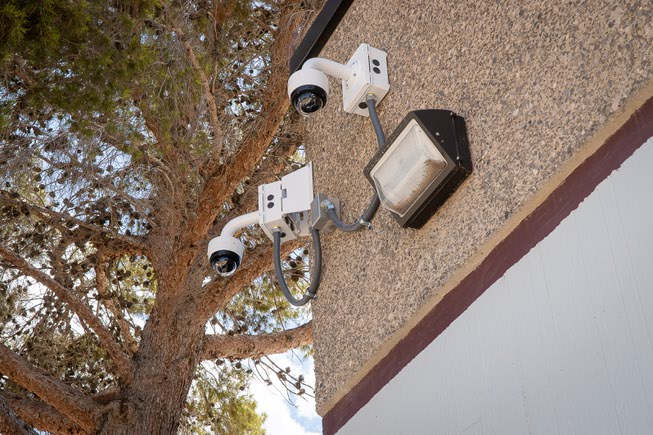
Security camera upgrades at Eldorado High School located in the east valley of Las Vegas. Tuesday, July 12, 2022.
Friday, Dec. 1, 2023 | 2 a.m.
Safety is a feeling, not a condition — and in the school setting, climate is also a feeling, said one longtime school district leader.
And they come together.
Speaking at a school safety and security conference this week in Las Vegas, retired Eureka County School District Superintendent Dan Wold told attendees that a school’s climate and culture were the missing pieces in school safety.
There are visible, physical improvements to school grounds, and Eureka County has done them to the tune of more than $800,000 in the last five or so years — bollards in front of large windows, upgraded exterior lighting, cameras, trauma kits for major injuries.
It was a major investment. Rural Eureka County has only about 300 students over three campuses. That same level of physical upgrades would cost about $1.2 billion if done across the Clark County School District, which has more than 350 schools, Wold said.
Then there are behaviors that shape climate and culture that don’t have to cost money.
“Climate is what it feels like to be here. It’s back to that feeling, right, what it feels like,” Wold said. “And culture is how we treat each other here.”
Teachers can keep students engaged “bell to bell,” leaving no down time at the beginning or end of class, he said.. They can supervise them during non-instructional settings — his own research showed that the majority of student misbehavior occurred outside of the classroom, and the problem behaviors that happened in class were within the first five or last minutes. In other words, few bad behaviors happened during supervised instruction.
Schools can teach coping skills that allow children to de-escalate situations on their own rather than act out. They can follow discipline plans objectively and fairly.
And they can build relationships — student to student, student to staff, and staff to staff.
Feeling safe in school also powerfully promotes student learning, and a positive climate helps retain staff, Wold said.
“We’re in an era of unprecedented resources – grants, funding of all kinds,” he said. “We might as well spend it on safety stuff. But we can all focus on academic improvement through developmental engagement. What does that cost?”
Wold’s talk was one of several breakout sessions over the three day, 12th annual National Student Safety and Security Conference and Workshop, which began Wednesday and continues through today at the Palms. It’s one of five such student safety and security conferences that take place every year around the country.
Some other breakout sessions covered student and staff mental health, cybersecurity and cyberbullying, youth suicide prevention, civilian response to active shooters, mass-shooter defense practices, how to respond to a fatal bus wreck, and how on-campus police contribute to school security programs. There were also product demonstrations for advanced metal detectors and bullet-resistant window coatings.
